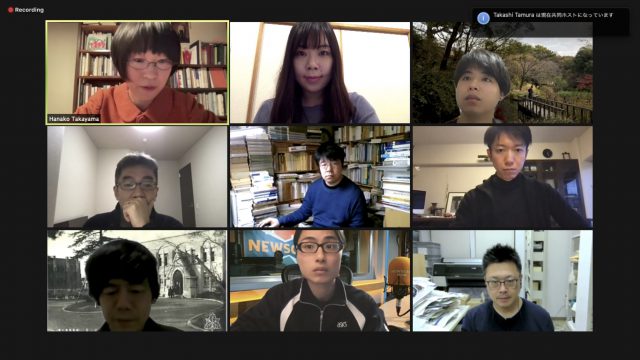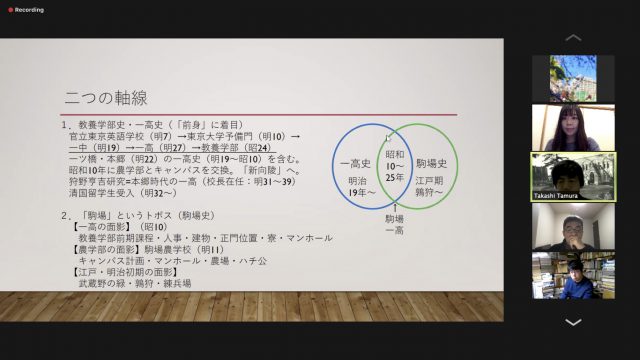On February 5, 2021, from 5 p.m., the fifth workshop for the Building 101 film production project was held. Due to the coronavirus pandemic, the meeting was conducted online using Zoom. The participants of this meeting were Tsuyoshi Ishii (University of Tokyo), Hanako Takayama (EAA Project Assistant Professor), and three EAA research assistants in charge of the Building 101 film project—Satoshi Takahara, Shuichiro Higuma, and myself, Sho Kotegawa—as well as Futoshi Hoshino (Waseda University), Katsuya Orimo (University of Tokyo), Sana Sakihama (EAA Project Research Fellow), and Takashi Tamura (University of Tokyo) as advisors.

Takashi Tamura started things off by suggesting that this project could be oriented in two ways: the history of the institution, which can be traced back to an English language school; or the overlapping images of various times in the topos of Komaba. In his presentation, Tamura not only mentioned the vestiges of the Komaba Agricultural School and the First High School era that remain on Komaba Campus (see the report of the third workshop), but also showed photographs where there were no plum, sweet osmanthus, and dawn redwood trees when the prepatory school (now Building 101) was built. Furthermore, in response to Futoshi Hoshino’s remarks at the second workshop, he introduced an article referring to “the physical warehouse” (butsuri soko, 物理倉庫).

To consider the prehistory of the First High School before it moved to Komaba, and at the same time, to pay attention to the relationship between Komaba Campus and the surrounding area, these perspectives presented by Takashi Tamura are important for understanding the reality of the students in the 1930s. As far as we have been able to find out from reading the dormitory diaries, the First High School students were frowned upon by quite a few people living in the Komaba area (see, for example, the film mentioned in the fourth workshop report), whereas according to Tsuyoshi Ishii and Katsuya Orimo, “the First High School culture” was rather well-received in the Hongo Campus era. What is interesting to us is that the First High School students criticized the negative reaction of the surrounding area in their dormitory diaries. Judging from such evidence, we believe that the students were trying to preserve their identity by “holing up” on the campus, where they could be separated from others and enhance their homogeneity as “First High School students.” Naturally, this obsession with homogeneity had the effect of fostering exclusivism. In fact, the First High School students at the time were urging the Chinese students to identify with “us” in the name of friendship and harmony.
When the research assistant mentioned the above after the presentation, Tsuyoshi Ishii and Katsuya Orimo responded that the same kind of sense of belonging and exclusiveness may be seen in our own day. Are not there, for example, any structural similarities between the environment of the Chinese students at that time and that of foreign students and of students joining the PEAK programs today? That is to say, we must also sharply reflect on our own identity when examining the identity of the First High School students.
Futoshi Hoshino also advised that reconstructing a relationship between narrative, image, and sound might be effective in making a film. He shared his memories of walking around the Komaba area with the poet Gozo Yoshimasu more than a decade ago. Listening to Yoshimasu’s stories based on his recollections of the late 1970s, Hoshino walked around the Komaba area and from what Yoshimasu said there emerged a peculiar sense in his mind of the slippages in time, even though they were sharing the same space. Separation and integration of voice and image: using such a method, it may be possible to position the space of Komaba as a unique topos where many different times are intertwined. In this way, this workshop with the advisors was inspiring and informative.
Reported by Sho Kotegawa (EAA Research Assistant)








